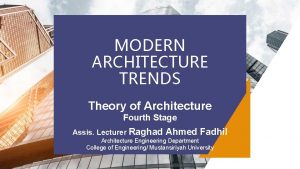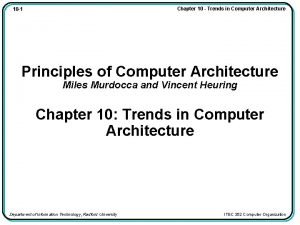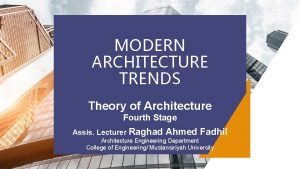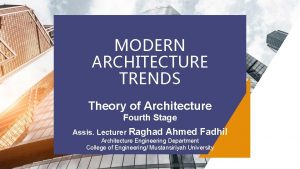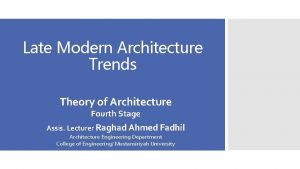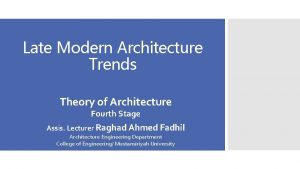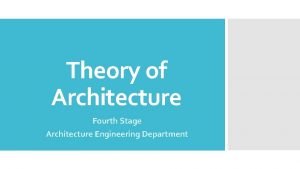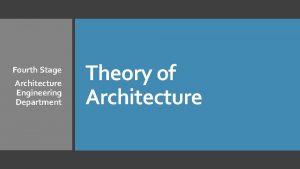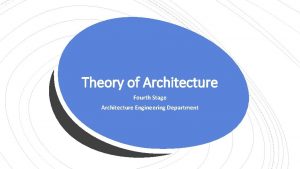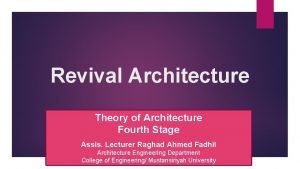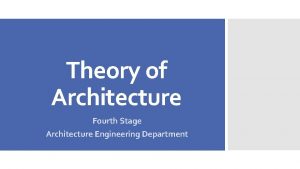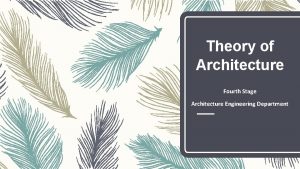MODERN ARCHITECTURE TRENDS Theory of Architecture Fourth Stage











- Slides: 11

MODERN ARCHITECTURE TRENDS Theory of Architecture Fourth Stage Assis. Lecturer Raghad Ahmed Fadhil Architecture Engineering Department College of Engineering/ Mustansiriyah University

MODERN ARCHITECTURE TRENDS PRAIRIE SCHOOL Circumstances • Prairie School is a late 19 th- and early 20 th-century architectural style, most common to the Midwestern United States. It has its roots in the city of Chicago, but its influence was felt around the world. • The emergence of the Prairie School style was nourished by a small group of architects. They wanted to develop an architecture style suitable to the American Midwest and independent of historical and revivalist influence. • The Prairie School was heavily influenced by the philosophy of Ralph Waldo Emerson, who believed that better homes would create better people. • it shared an embrace of handcrafting and THE FREDERICK C. ROBIE HOUSE craftsmanship as the Arts and Crafts Movement U. S. CHICAGO, 2 reaction to the dehumanizing effects of mass 1909 - 1910, FRANK LLOYD WRIGHT production.

MODERN ARCHITECTURE TRENDS PRAIRIE SCHOOL Characteristics • The style is usually marked by: • 1. horizontal lines • 2. flat or hipped roofs with broad overhanging eaves • 3. windows grouped in horizontal bands • 4. integration with the landscape, • 5. solid construction, • 6. Craftsmanship • 7. discipline in the use of ornament 3 THE FREDERICK C. ROBIE HOUSE U. S. CHICAGO, 1909 - 1910, FRANK LLOYD WRIGHT

MODERN ARCHITECTURE TRENDS CONSTRUCTIVIST ARCHITECTURE • Constructivist architecture, or ‘constructivism’, is a form of modern architecture that developed in the Soviet Union in the 1920 s. Inspired by the wider constructivist art movement that emerged from Russian Futurism. • The movement became outdated in the mid-1930 s, but it has had a definite influence on many subsequent architectural movements, such as Brutalism. 4

MODERN ARCHITECTURE TRENDS CONSTRUCTIVIST ARCHITECTURE Characteristics • 1. The combination of modern technology and engineering. • 2. The socio-political principles of Communism. • 3. the application of 3 D cubism to abstract and nonobjective elements. • 4. The style incorporated straight lines, cylinders, cubes and rectangles; and merged elements of the modern age such as radio antennae, tension cables, concrete frames and steel girders. • 5. The possibilities of modern materials were also explored, such as steel frames that supported large areas of glazing, exposed rather than concealed building joints, balconies and sun decks. • 6. The style aimed to explore the opposition between different forms as well as the contrast between different surfaces, predominately between solid walls and windows, 5 which often gave the structures their characteristic sense of scale and presence. Zuev Workers' Club, 1926

MODERN ARCHITECTURE TRENDS CONSTRUCTIVIST ARCHITECTURE • Tatlin's Tower • 1919 • (Vladimir Tatlin)

MODERN ARCHITECTURE TRENDS De Stijl Dutch for "The Style", also known as Neoplasticism, was a Dutch artistic movement founded in 1917 in Leiden. De Stijl consisted of artists and architects. De Stijl is also the name of a journal. the group's principal members were the painters Piet Mondrian, Vilmos Huszár, and Bart van der Leck, and the architects Gerrit Rietveld, Robert van 't Hoff, and J. J. P. Oud. De Stijl advocated pure abstraction and universality by a reduction to the essentials of form and color. they simplified visual compositions to vertical and horizontal, using only black, white and primary colors.

MODERN ARCHITECTURE TRENDS DE STIJL IN ART Characteristics • In painting, the neoplastic characteristics are : • 1. the geometric abstraction, which means the use of few, basic geometric elements, such as the line and the right angle. • 2. The use of only primary colors – together with black, white and gray – is predominant. • 3. Rectangles and repeated blocks – as in the famous Mondrian’s paintings. 8 to achieve harmony through the balance of the relationship between lines, colors and planes. But only in clearest and strongest way”. (Piet Mondrian)

MODERN ARCHITECTURE TRENDS DE STIJL IN ARCHITECTURE Characteristics • 1. colored areas correspond to solid and the noncolored (neutral) areas match the void. • 2. In many of the group's three-dimensional works, vertical and horizontal lines are positioned in layers or planes that do not intersect, thereby allowing each element to exist independently and unobstructed by other elements. • 3. The De Stijl movement posited the fundamental principle of the geometry of the straight line, the square, and the rectangle, combined with a strong asymmetricity. • 4. The use of elements in an arrangement of nonobjective forms and lines. 9

MODERN ARCHITECTURE TRENDS 1. White primary elements to shape the house and its structure. 2. Gray or white plain elements to define the relationship between inside and outside. 3. Linear elements, vertical and horizontal – lintels, pillars, drainpipes – colored in yellow, red and blue combined with white, gray and black; 4. Functional elements – windows, doors, railings, exterior staircase and skylight – colored in black and white. 10 5. the interior spaces have been organized according to the function they are intended to: on the ground floor there are the rooms to eat, study and work, bounded by Schröder walls. On the upper floor, in a. The unique environment, definable through the use of. House, sliding walls, there are the areas to sleep and for intellectual activities. All the T. G. furnishing inside the house has been. Rietveld design by the Architect De Stijlas well. (1924)

THANK YOU
